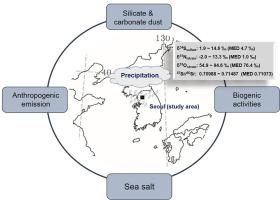Environmental Pollution ( IF 8.9 ) Pub Date : 2021-06-10 , DOI: 10.1016/j.envpol.2021.117548 Yeongmin Kim 1 , Insung Lee 2 , James Farquhar 3 , Jisuk Kang 4 , Igor M Villa 5 , Hyoungbum Kim 6

|
Multiple sulfur (δ34Ssulfate, Δ33Ssulfate, & Δ36Ssulfate), nitrogen and oxygen (δ15Nnitrate & δ18Onitrate) and strontium (87Sr/86Sr) isotope compositions of precipitation collected from Seoul, South Korea were analyzed to study the sources, transportation and deposition of air pollutants in East Asia. The δ34Ssulfate values (from 1.9 to 14.6‰ with a median of 4.7‰) and the δ15Nnitrate values (from −2.0 to 13.3‰ with a median of 1.0‰) suggest that fossil fuel use (emission from coal combustion and vehicle exhaust) is a predominant source for sulfur and nitrogen, but other natural sources including biogenic contributions of DMS also add to their total budget. The seasonal variations are observed in δ34Ssulfate and δ15Nnitrate values (both higher in winter season), which is likely to result from the increase of coal use for domestic heating in China. The δ18Onitrate values also varied seasonally depending on the NOx oxidation pathway, being about 20‰ higher in winter than in summer season. The Δ33Ssulfate and Δ36Ssulfate values are not anomalous, showing the absence of MIF signals in precipitation of Seoul. The 87Sr/86Sr ratio of the precipitation samples range from 0.70988 to 0.71487 with a median of 0.71073, indicating the influence of at least three end-member (silicate dust, carbonate dust and anthropogenic emission). Ionic ratios such as (K++NH4+)/(Ca2++Mg2+) and Cl−/Na+ suggest the overwhelming effect of anthropogenic input rather than carbonate dust on the end-member with lower 87Sr/86Sr ratios.


























 京公网安备 11010802027423号
京公网安备 11010802027423号